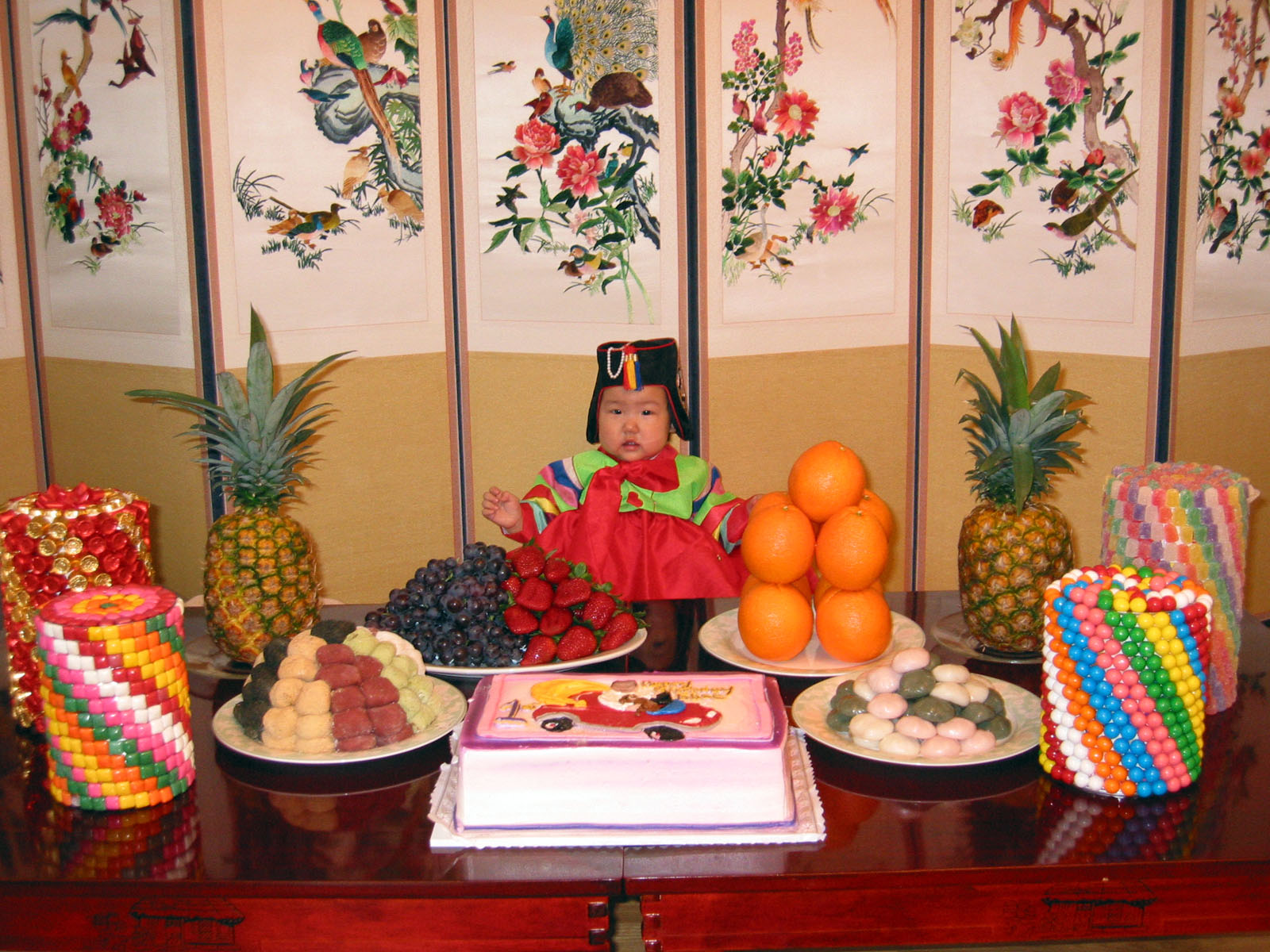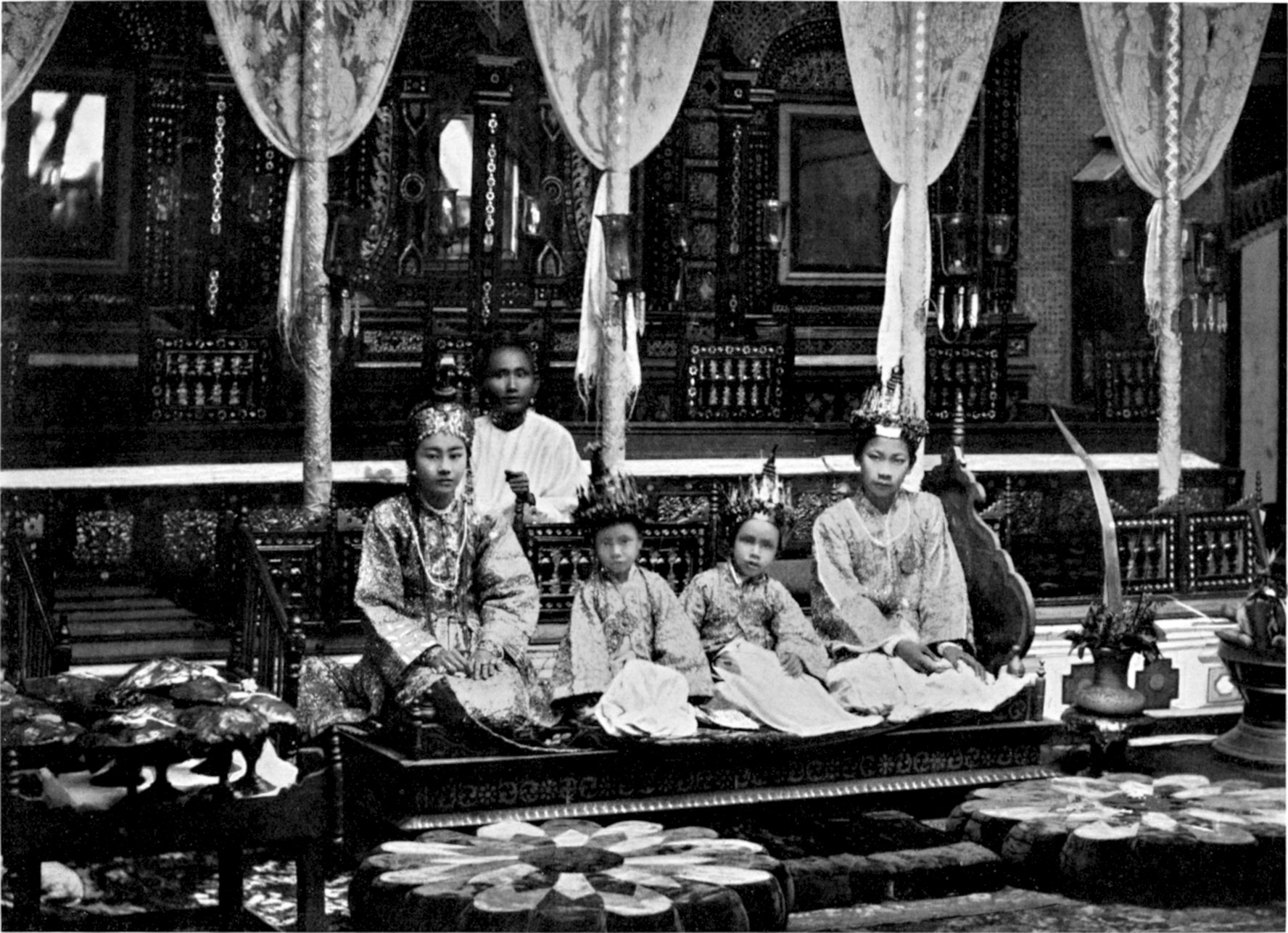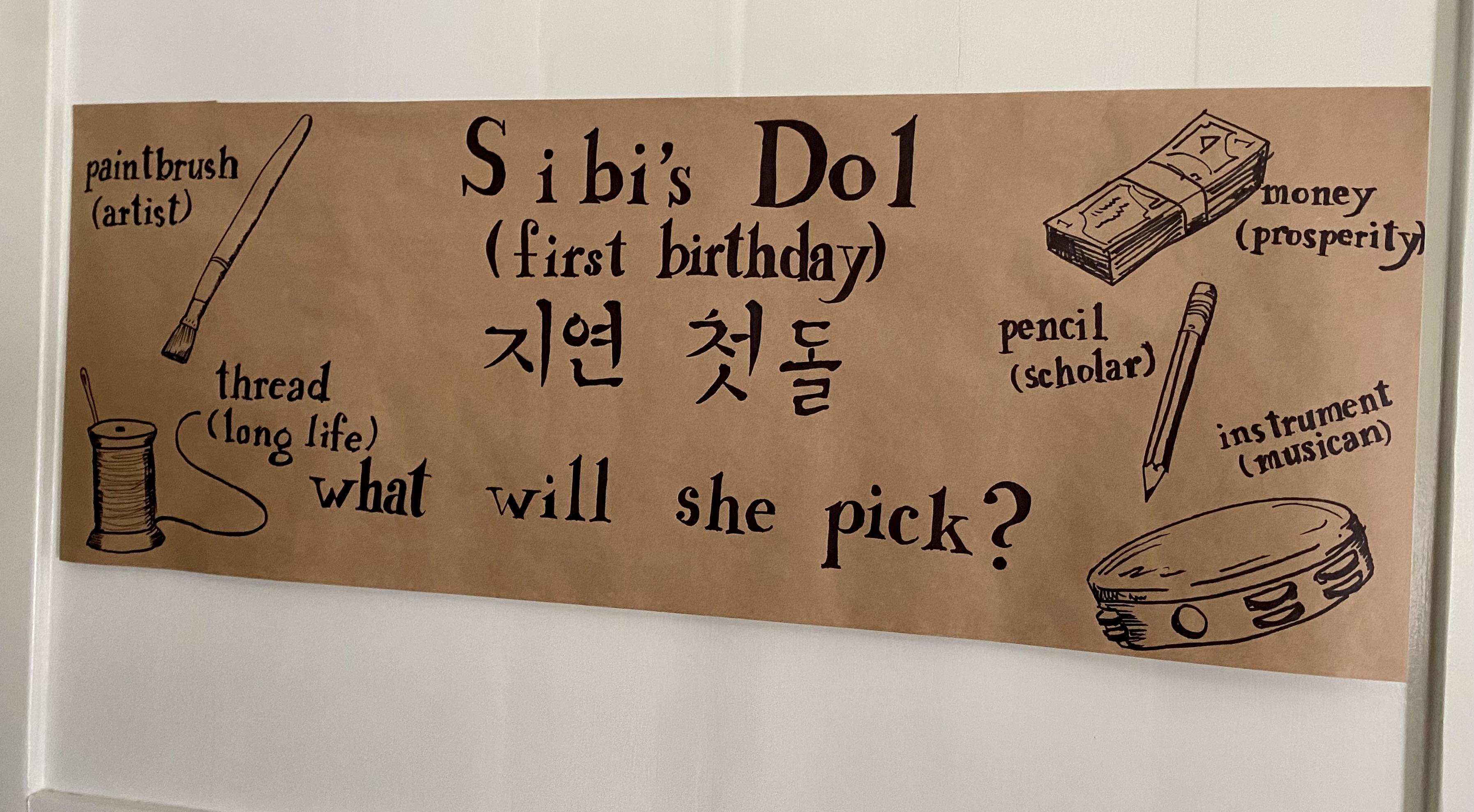|
Korean Birthday Celebrations
Korean birthday celebrations or Dol are one of the important facets of Korean culture. When a person reaches an important age in his or her life, Koreans have unique celebrations to mark these milestones. Dol means it has been 365 days since the baby's birth. ''Dol'' (돌) ''Dol'' (''doljanchi'', or ''tol'') is probably one of the best-known of the Korean birthday celebrations. ''Dol'' is celebrated for the first year of a child. The first part of the ''dol'' celebration is prayer. Traditionally, Koreans would pray to two of the many Korean gods: ''Sanshin'' (the mountain god) and ''Samshin'' (the birth goddess). Koreans would prepare the praying table with specific foods: a bowl of steamed white rice, seaweed soup (miyeok-guk) and a bowl of pure water. Layered red bean rice cakes (''samshin siru'') were placed next to the prayer table. The rice cakes were not shared outside the family; it was believed that sharing this particular item with people outside the family would bring ... [...More Info...] [...Related Items...] OR: [Wikipedia] [Google] [Baidu] |
Culture Of Korea
The traditional culture of Korea is the shared cultural and historical heritage of Korea and southern Manchuria before the division of Korea in 1945. Manchuria refers to the ancient geographical and historical region in Northeast Asia, including countries like China and Russia. Since the mid-20th century, Korea has been split between the North Korean and South Korean states, resulting in a number of cultural differences that can be observed even today. the practice of Confucianism and Korean shamanism is deeply rooted in Korean culture. Clothing The traditional dress known as ''hanbok'' (한복, 韓服) (known as ''joseonot'' ��선옷in the DPRK). The ''hanbok'' consists of a shirt (''jeogori'') and a skirt (''chima''). According to social status, Koreans used to dress differently, making clothing an important mark of social rank. Costumes were worn by the ruling class and the royal family. These upper classes also used jewelry to distance themselves from the ordinar ... [...More Info...] [...Related Items...] OR: [Wikipedia] [Google] [Baidu] |
Korean Calendar
The traditional Korean calendar or Dangun calendar () is a lunisolar calendar. Dates are calculated from Korea's meridian (135th meridian east in modern time for South Korea), and observances and festivals are based in Korean culture. Koreans mostly use the Gregorian calendar, which was officially adopted in 1896. However, traditional holidays and age-reckoning for older generations are still based on the old calendar. The biggest festivals in Korea today, which are also national holidays, are Seollal, the first day of the traditional Korean New Year, and Chuseok its harvest moon festival. Other important festivals include Daeboreum also referred to as ''Boreumdaal'' (the first full moon), Dano (spring festival) and Samjinnal (spring-opening festival). Other minor festivals include Yudu (summer festival), and Chilseok (monsoon festival). History Like most traditional calendars of other East Asian countries, the Korean Calendar is mainly derived from the Chinese calendar. Th ... [...More Info...] [...Related Items...] OR: [Wikipedia] [Google] [Baidu] |
Korean Cuisine
Korean cuisine has evolved through centuries of social and political change. Originating from ancient agricultural and nomadic traditions in Korea and southern Manchuria, Korean cuisine reflects a complex interaction of the natural environment and different cultural trends. Korean cuisine is largely based on rice, vegetables, seafood and (at least in South Korea) meats. Dairy is largely absent from the traditional Korean diet. Traditional Korean meals are named for the number of side dishes (반찬; 飯饌; ''banchan'') that accompany steam-cooked short-grain rice. Kimchi is served at nearly every meal. Commonly used ingredients include sesame oil, ''doenjang'' (fermented bean paste), soy sauce, salt, garlic, ginger, ''gochugaru'' (pepper flakes), '' gochujang'' (fermented red chili paste) and napa cabbage. Ingredients and dishes vary by province. Many regional dishes have become national, and dishes that were once regional have proliferated in different variations ... [...More Info...] [...Related Items...] OR: [Wikipedia] [Google] [Baidu] |
Rites Of Passage
A rite of passage is a ceremony or ritual of the passage which occurs when an individual leaves one group to enter another. It involves a significant change of status in society. In cultural anthropology the term is the Anglicisation of ''rite de passage'', a French term innovated by the ethnographer Arnold van Gennep in his work ''Les rites de passage'', ''The Rites of Passage''. The term is now fully adopted into anthropology as well as into the literature and popular cultures of many modern languages. Original conception In English, Van Gennep's first sentence of his first chapter begins: "Each larger society contains within it several distinctly separate groupings. ... In addition, all these groups break down into still smaller societies in subgroups." The population of a society belongs to multiple groups, some more important to the individual than others. Van Gennep uses the metaphor, "as a kind of house divided into rooms and corridors." A passage occurs when an indiv ... [...More Info...] [...Related Items...] OR: [Wikipedia] [Google] [Baidu] |
Twelve Auspicious Rites
The Twelve Auspicious Rites ( my, လောကီမင်္ဂလာဆယ့်နှစ်ပါး, , and ) are a series of worldly rites of passage recognized in traditional Burmese culture, particularly by the Bamar. These are distinct from the Thirty-eight Buddhist Beatitudes described in the Maṅgala Sutta. In modern times, only four or five of these rites — the naming, first feeding, ear-boring, shinbyu, and wedding rites — are commonly practiced in Myanmar, especially in urban cities. In pre-colonial Burma, Brahmins typically consecrated or led these rites. Today, masters of ceremony who specialize in abhisheka rituals, called ''beiktheik saya'' (ဘိသိက်ဆရာ), consecrate these rites. ''Beiktheik saya'' derive their skills from four Vedic scriptures, namely Sāmaveda, Yajurveda, Atharvaveda, and Rigveda, in addition to Pali scriptures. List of rites # () – the successful delivery of a child # () – the taking of refuge in the Three Jewels, w ... [...More Info...] [...Related Items...] OR: [Wikipedia] [Google] [Baidu] |
East Asian Age Reckoning
Countries in the East Asian cultural sphere (China, Korea, Japan, Vietnam, and their diasporas) have traditionally used specific methods of reckoning a person's numerical age based not on their birthday but the calendar year, and what age one is considered at birth. These methods currently see only limited use in certain contexts and areas, mainly in South Korea and Taiwan. A person's age will always be one or two years greater than his or her age in the international norm. In the context of South Korea, this reckoning is often referred to as Korean age, but in 2022, the government of South Korea announced plans to switch from this Korean age system to the system used by most other countries in the world. In traditional China, where the system originated millennia ago, people were considered to be ''one "year old"'' at birth (one ''sui'' 嵗/岁), and on New Year's Day of the lunar calendar, another year was added to their age. In other words, age was counted with ordinal n ... [...More Info...] [...Related Items...] OR: [Wikipedia] [Google] [Baidu] |
Doljanchi
''Dol'' or ''doljanchi'' is a Korean tradition that celebrates the first birthday of a baby. This ceremony blesses the child with a prosperous future and has taken on great significance in Korea. The birthday babies wear a hanbok and a traditional hat: a ''jobawi'' or ''gulle'' for baby girls and a ''bokgeon'' or ''hogeon'' (호건) for baby boys. History In the past, the death rates for children were high and many children died before their first birthday, so it was an important milestone for the baby and parents. The whole village used to celebrate a baby's first birthday, sharing food and wishing for long life and fortune for the baby. It could also define who they would be when they grow older. Doljabi (돌잡이): fortune telling custom The highlight of the dol (돌) is a custom called the doljabi (돌잡이) where the child is placed in front of a table of foods and objects such as string, paint or calligraphy brushes, ink, and money. The child is then urged to pick up ... [...More Info...] [...Related Items...] OR: [Wikipedia] [Google] [Baidu] |
Binyeo
A (Hangul: ; ) is a Korean traditional hairpin for fixing ladies' chignons. Its main purpose is to pin the chignon in place, but it also serves as ornamentation, and it has different usages or names according to its material or shape. Therefore, it is possible to identify one's social status by looking at their . are divided into two kinds, a (; ) and a ( ). have a long body and have an upturned 'U' shape. are usually used by women, but they are also used by men to fix their (topknots) in place. In the Joseon Dynasty, on the day of becoming an adult, girls held a coming of age ceremony by putting in their hair. In the ascension myth , which is passed down in the Hamgyeong-do area, it also appears as a medium for to meet the two loved ones. Origin Binyeo, according to historical records, are traced back to use during the Three Kingdoms Era, usually worn with a Goryeo ladies' hair style similar to chignons. Details surrounding the use of the binyeo became more detailed s ... [...More Info...] [...Related Items...] OR: [Wikipedia] [Google] [Baidu] |
Horsehair
Horsehair is the long hair growing on the manes and tails of horses. It is used for various purposes, including upholstery, brushes, the bows of musical instruments, a hard-wearing fabric called haircloth, and for horsehair plaster, a wallcovering material formerly used in the construction industry and now found only in older buildings. Horsehair can be very fine and flexible; mane hair is generally softer and shorter than tail hair. The texture of horsehair can be influenced by the breed and management of the horse, including natural conditions such as diet or climate. Processing may also affect quality and feel. Horsehair is a protein fiber that absorbs water slowly, but can be dyed or colored effectively using traditional dyes suitable for protein fibers. It can be felted, but not easily. Uses Horsehair fabrics are woven with wefts of tail hair from live horses and cotton or silk warps. Horsehair fabrics are sought for their lustre, durability and care properties a ... [...More Info...] [...Related Items...] OR: [Wikipedia] [Google] [Baidu] |
Gat (hat)
A ''gat'' ( ) is a Korean traditional hat worn by men along with ''hanbok'' (Korean traditional clothing) during the Joseon period. It is made from horsehair with a bamboo frame and is partly transparent. Most ''gat'' are cylindrical in shape with a wide brim on a bamboo frame. Before the late 19th century, only noble class men could wear ''gat'', which represented their social status and protected their topknots (). Artisans who make ''gat'' are called ''ganniljang'' (), from ''gannil'' (, a compound of two words ''gat'' and ''il'' (work); "''gat'' making") + ''jang'' ( "artisan, craftsperson, master of a craft"). As ''gannil'' requires artisanship throughout a complex series of techniques involving an array of materials, it has been designated as Intangible Cultural Property No. 4 on December 24, 1964. History The origins of ''gat'' date back to ancient times. Usually, the following hats are considered to be the first specimens of what is known as gat today: the so-called ''i ... [...More Info...] [...Related Items...] OR: [Wikipedia] [Google] [Baidu] |
Folk Music
Folk music is a music genre that includes traditional folk music and the contemporary genre that evolved from the former during the 20th-century folk revival. Some types of folk music may be called world music. Traditional folk music has been defined in several ways: as music transmitted orally, music with unknown composers, music that is played on traditional instruments, music about cultural or national identity, music that changes between generations (folk process), music associated with a people's folklore, or music performed by custom over a long period of time. It has been contrasted with commercial and classical styles. The term originated in the 19th century, but folk music extends beyond that. Starting in the mid-20th century, a new form of popular folk music evolved from traditional folk music. This process and period is called the (second) folk revival and reached a zenith in the 1960s. This form of music is sometimes called contemporary folk music or folk rev ... [...More Info...] [...Related Items...] OR: [Wikipedia] [Google] [Baidu] |
Medicine
Medicine is the science and practice of caring for a patient, managing the diagnosis, prognosis, prevention, treatment, palliation of their injury or disease, and promoting their health. Medicine encompasses a variety of health care practices evolved to maintain and restore health by the prevention and treatment of illness. Contemporary medicine applies biomedical sciences, biomedical research, genetics, and medical technology to diagnose, treat, and prevent injury and disease, typically through pharmaceuticals or surgery, but also through therapies as diverse as psychotherapy, external splints and traction, medical devices, biologics, and ionizing radiation, amongst others. Medicine has been practiced since prehistoric times, and for most of this time it was an art (an area of skill and knowledge), frequently having connections to the religious and philosophical beliefs of local culture. For example, a medicine man would apply herbs and say prayers for healing, o ... [...More Info...] [...Related Items...] OR: [Wikipedia] [Google] [Baidu] |







.jpg)



